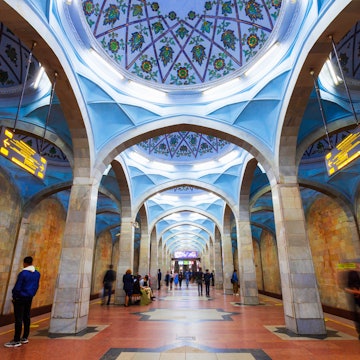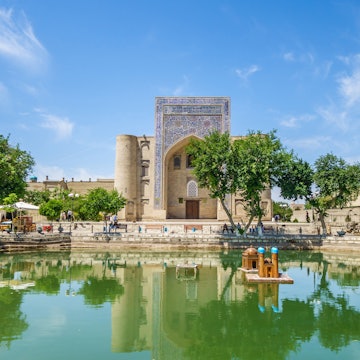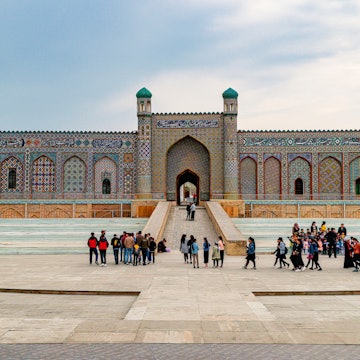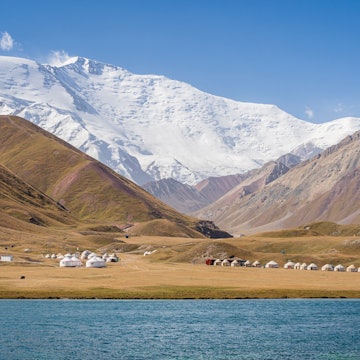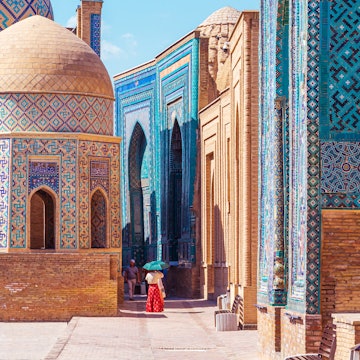

Get to know Uzbekistan with this guide to the top places to visit, like the historic center of Bukhara. Shutterstock
Set at the crossroads of the ancient Silk Road, Uzbekistan is famed for its stunning historical architecture and beautiful mosques and medressas, alongside Soviet modernism, a flourishing arts and crafts scene, a rich traditional culture, and the genuine hospitality of local people.
The continental climate brings four distinct seasons, and escaping into nature and visiting off-the-beaten-track destinations are adventures that will leave lifetime memories.
Here are our top recommendations of places to visit in Uzbekistan for architecture, culture, nature and immersion in the arts.
1. Registan, Samarkand
Best for dramatic architecture
The historic Registan Square in Samarkand impresses first-time visitors more than any other attraction in Uzbekistan. Included on the UNESCO World Heritage list, the square consists of three striking medressas – the Ulugbek, Sherdor and Tilla-Kori – which together served as a university for Islamic scholars. The name Registan means "a sand place." Since the Timurid period, this has been a place where people have met, important decisions were announced, and crucial events in Uzbekistan’s history occurred.
Samarkand is blessed with many other historical attractions, including the Bibi-Khanym Mosque, the Shah-i-Zinda Necropolis, the Gur-e-Amir mausoleum and Ulugbek’s Observatory – all of them well worth visiting. One day might be enough to cover most important stops, but if you want to enjoy the pace of life in Samarkand, wander around talking to local craftspeople and leave some time for tea and local cuisine, allow two days or more.
Local tip: Opened in 2022, Samarkand International Airport is the second-biggest airport in the country and a good entry point to Uzbekistan. Turkish Airlines, WizzAir, AirDubai, FlyAirstan, Jazeera Air and several Uzbek airlines operate regular flights to this modern airport. From Samarkand, it’s easy to travel around the country by rail – to Bukhara, Khiva and Nukus and then fly back to the capital Tashkent.

2. Bukhara
Best for history
In Samarkand, an ancient mosque might sit alongside an office tower or a modern neighborhood, but Bukhara’s old city really makes you travel in time. Protected by UNESCO, the historical part of the city still feels completely authentic, with timeless mosques, minarets, medressas, craft workshops, caravanserais and local eateries. Set around an artificial pool called Labi Hovuz, the central square has a unique atmosphere and is a great place to admire the architecture, enjoy local food, sip tea, slurp ice cream, bargain with souvenir sellers, or just have a breather sitting on a bench in the sun.
There are many must-visit stops in Bukhara. Be sure to make time for the Ark, a former residence of Bukhara Emir, the eye-catching medressas of Mir-i-Arab, Nadir Divanbegi and Abdul Aziz Khan, the Kalon Minaret, and the inspiring Sitorai Mohi Hosa summer palace.
While the old city might seem compact on the map, Bukhara deserves at least two full days. This is one of those cities where you can discover endless new layers each time you return.
Planning tip: Multicultural, ancient and packed with interesting experiences, Bukhara is best enjoyed in spring and autumn when the weather is not too hot or too cold.
3. The Savitsky Museum in Nukus
Best stop for art lovers
Karakalpakstan, an autonomous republic in the west of Uzbekistan, lures many visitors thanks to the unusual landscapes of the Aral Sea, the Ustyurt Plateau and the ancient fortresses in the surrounding desert. But one of the most interesting destinations is the Savitsky Museum (or the Nukus Museum of Art) in the regional capital, Nukus. It displays a vast collection of Russian avant-garde art, secretly preserved during Soviet times. Its founder, Igor Savitsky, was an art connoisseur who saved roughly 100,000 artworks, showcasing the rich lifestyle and heritage of people in this area.
Planning tip: Trains from Tashkent to Nukus can take more than 20 hours; many travelers arrive by air to maximize time for sightseeing.

4. Ichan Kala, Khiva
Best for stepping into the past
The open-air museum that is the city of Khiva used to be the capital of the Khorezm Shakhs and later the hub of the Khiva Khanate, and it still preserves its own language, traditions and culture. The fascinating Ichan Kala (which means “inner city”) is the fortress in the heart of Khiva, and most of the architectural attractions are there. Visit the atmospheric Juma mosque, the Tosh-Hovli Palace (with its harem rooms for wives of the ruler), and the Kalta Minor minaret, and you’ll feel the grandeur and tranquility of Central Asia in the Middle Ages.
Some of the historic buildings have been transformed into boutique hotels; it feels unusual to stay overnight in a room of medieval features but with all the modern facilities you could want, such as air-conditioning and a hot shower. Get to know the culture of Khiva through classes, from baking bread all the way to lessons in energetic Khorezm dancing.

5. Margilan
Best for lovers of traditional art forms
Moving from historical to artistic sites, the city of Margilan in the Fergana Valley is a great place to discover the history of ikat – the weaving of textiles with designs pre-dyed into the fibers. This unique weaving technique has independently developed in many different parts of the world, including in Indonesia, Japan, India and Latin America, but the Silk Road made Uzbek ikat particularly famous, thanks to its quality and the variety of the fabrics produced in silk, cotton and velvet.
Margilan is a cozy small town where you can visit long-established makers of Central Asian ikat at the Yodgorlik Silk Factory, speak to modern weavers at local crafts centers, or just enjoy the abundance of the local farmers market and the laid-back lifestyle of this mainly agricultural area.
Planning tip: Margilan has been a hub for silk production since the time of the Silk Road; get here easily by shared taxi from Fergana or train from Tashkent. Come on Thursday or Sunday for the local market.
6. Rishtan
Best for ceramics fans
There is probably no other city in the world with quite so many ceramic artists as Rishtan. As soon as you enter the town, you will see pottery items for sale on both sides of the highway. But don’t rush to buy here because you will find better quality and more authentic works in the studios of local craftspeople.
Rishtan was already famous for glazed ceramics 1000 years ago, thanks to the soil – the richest source of terracotta clay in the region. The workshops of Alister Nazirov and Rustam Usmanov are famous for preserving and popularizing the ancient techniques of Uzbek ceramics art. However, there are many skilled crafters and ceramics centers for all tastes and budgets in the city.

7. Tashkent
Best stop for city slickers
The Uzbek capital, Tashkent, is not just an entry point to the country, but a diverse and fascinating destination in its own right. Islamic architecture, vibrant avenues, art and history museums, theaters, international gastronomy and nightlife make for a modern, cosmopolitan experience.
Start with a visit to central Amir Timur square, where you can drop into the Amir Timur Museum, view the Amir Timur monument and the Tashkent clock tower (which now hosts two quirky restaurants), and visit a famous piece of Soviet monumental architecture, the Hotel Uzbekistan.
Nearby, so-called Broadway Street is especially colorful in the evening with souvenir shops, street food and amusements. A short hop west, Tashkent City Park offers plenty of ways to keep busy, with an aquarium, planetarium, dancing fountains and street shows, as well as diverse restaurants, modern hotels, shopping malls and an open-air cinema. For a shopping treasure hunt, head to the vast Chorsu Bazaar, Tashkent’s best-loved marketplace, or the Navruz Ethnopark to discover traditional clothing and accessories, local crafts and authentic Uzbek food.
8. Konigil Village
Best crafts stop if you’re short on time
On the outskirts of Samarkand, the village of Konigil is an atmospheric destination. This village is an amazing place to learn about the crafts of the region in one place. The Meros Paper Mill specializes in traditional silk paper, and you can also see the production of vegetable oil, ceramics, carpets and other local crafts. There are places to sample local food and even a small guest house, conveniently located in one tranquil space near the small, tree-shaded Siab River. Time slows down here, and it’s a beautiful escape for a half day or more.

9. Zaamin National Park
Best escape for nature lovers
Among the many picturesque mountain areas in Uzbekistan, Zaamin National Park holds a special place in the hearts of locals, thanks to its unspoiled natural scenery. Until recently, this picturesque destination east of Samarkand was off the radar of foreign tourists but well-explored by the people of the area. The air of Zaamin is considered to have healing properties, and nature in this area is pure and abundant, which often draws comparisons to Switzerland.
Many distinct types of flora and fauna are found here, including black storks, black bears, lynx and snow leopards. There’s a beautiful lake-like reservoir and great trails for hiking, and people come there in summer and winter to stay in the area’s new international hotels and run in the Zaamin Ultramarathon in June.







